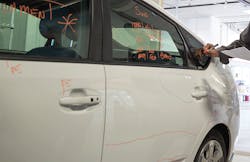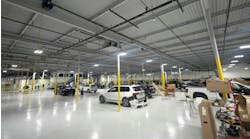Scott Calhoon, the son of an accomplished residential builder, has always valued the blueprinting process.
Drawing up a solid plan, the younger Calhoon has learned, often serves as the foundation for business success. And that’s as true in collision repair as it is in construction.
That’s why, during his days as a body shop estimator, Scott Calhoon used to become irritated by unexpected delays caused by coworkers needing to stop the repair process to order extra parts.
“The biggest aggravation to me is a technician [asking], three or four days into the process, ‘Why don’t I have this part?’” Calhoon says. “If you have a good plan, and a good process, then ultimately the job will run much smoother—much more efficiently, much quicker.”
Over the last decade, Calhoon—now the body shop manager at Five Star Chrysler Dodge
Jeep Ram, in Macon, Ga.—has worked to refine the facility’s blueprinting process. And, at the outset of 2019, his work appears to be paying off: the body shop generates around $4.5 million annually, and possesses a 95.8 CSI score.
Below, he explains the keys to an effective blueprinting process.
Disassemble Vehicles Consistently.
In Calhoon’s opinion, the biggest blueprinting mistake most shops make is failing to fully disassemble cars early on, in an effort to take note of the full scope of damage. Making matters worse, though, is the fact most shops don’t disassemble a vehicle with respect to how their estimating system is written, or with estimators overseeing the process.
“If you go disassemble the car,” Calhoon says, “and the estimating system is written from front to rear, then disassemble the car in the same fashion. That way you don’t miss stuff. If you went from disassembling everything in the front bumper group [to eventually] disassembling the fender, that way you can work through the vehicle with a technician.”
And, Calhoon adds, “it’s very hard, if you go to write [a repair order] as an estimator, and everything’s sprawled out everywhere. It’s difficult for estimators, if they’re not there overseeing the disassembly process—there’s a chance they’re going to miss something.”
Have a Clear Process in Place.
In a similar vein, not having a clearly defined blueprinting process can result in costly delays for shops. A clear blueprinting procedure is necessary, Calhoon notes, because no two shop workers are likely to view damages from the exact same perspective.
Nowadays, Five Star Chrysler Dodge Jeep Ram utilizes the following process for blueprinting: First, a front-end estimator makes repair orders, marks damage, and takes photos. Next, a technician is dispatched. Damaged parts are all confined to one corner of the shop. Before long, an estimate is formulated. With all necessary employees aware of their blueprinting responsibilities, the process is rather efficient, Calhoon says.
“If you have one good plan you don’t have to revisit it two or three times, with starting and stopping … and redundancy,” he adds.
Utilize a Back-End Estimator.
Calhoon feels many shops are missing a key piece of the blueprinting puzzle: a “back-end” estimator, an employee who can focus almost entirely on blueprinting.
“The front-end estimator, at our shop, is really just a salesman, because you can’t write a full estimate out on the curb; you can only give a general idea,” he says. “Your technical [expert] needs to be your back-end estimator. Then you’ll have consistency and be consistent with your estimate writing.
“You’ve got to figure out how many cars you’re taking in a day, and then decide how many back-end estimators you’ll have. … The biggest thing is having the people—and putting the right people in place.”



